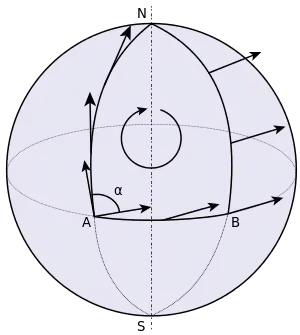
In geometry, parallel transport (or parallel translation[lower-alpha 1]) is a way of transporting geometrical data along smooth curves in a manifold. If the manifold is equipped with an affine connection (a covariant derivative or connection on the tangent bundle), then this connection allows one to transport vectors of the manifold along curves so that they stay parallel with respect to the connection.
The parallel transport for a connection thus supplies a way of, in some sense, moving the local geometry of a manifold along a curve: that is, of connecting the geometries of nearby points. There may be many notions of parallel transport available, but a specification of one — one way of connecting up the geometries of points on a curve — is tantamount to providing a connection. In fact, the usual notion of connection is the infinitesimal analog of parallel transport. Or, vice versa, parallel transport is the local realization of a connection.
As parallel transport supplies a local realization of the connection, it also supplies a local realization of the curvature known as holonomy. The Ambrose–Singer theorem makes explicit this relationship between the curvature and holonomy.
Other notions of connection come equipped with their own parallel transportation systems as well. For instance, a Koszul connection in a vector bundle also allows for the parallel transport of vectors in much the same way as with a covariant derivative. An Ehresmann or Cartan connection supplies a lifting of curves from the manifold to the total space of a principal bundle. Such curve lifting may sometimes be thought of as the parallel transport of reference frames.
Parallel transport on a vector bundle
Let M be a smooth manifold. Let E → M be a vector bundle with connection ∇ and γ: I → M a smooth curve parameterized by an open interval I. A section of along γ is called parallel if
By example, if is a tangent bundle of a manifold whereby is a tangent vector field, this expression means that, for every in the interval, tangent vectors in are "constant" (the derivative vanishes) when an infinitesimal displacement from in the direction of the tangent vector is done.
Suppose we are given an element e0 ∈ EP at P = γ(0) ∈ M, rather than a section. The parallel transport of e0 along γ is the extension of e0 to a parallel section X on γ. More precisely, X is the unique part of E along γ such that
Note that in any given coordinate patch, (1) defines an ordinary differential equation, with the initial condition given by (2). Thus the Picard–Lindelöf theorem guarantees the existence and uniqueness of the solution.
Thus the connection ∇ defines a way of moving elements of the fibers along a curve, and this provides linear isomorphisms between the fibers at points along the curve:
from the vector space lying over γ(s) to that over γ(t). This isomorphism is known as the parallel transport map associated to the curve. The isomorphisms between fibers obtained in this way will, in general, depend on the choice of the curve: if they do not, then parallel transport along every curve can be used to define parallel sections of E over all of M. This is only possible if the curvature of ∇ is zero.
In particular, parallel transport around a closed curve starting at a point x defines an automorphism of the tangent space at x which is not necessarily trivial. The parallel transport automorphisms defined by all closed curves based at x form a transformation group called the holonomy group of ∇ at x. There is a close relation between this group and the value of the curvature of ∇ at x; this is the content of the Ambrose–Singer holonomy theorem.
Recovering the connection from the parallel transport
Given a covariant derivative ∇, the parallel transport along a curve γ is obtained by integrating the condition . Conversely, if a suitable notion of parallel transport is available, then a corresponding connection can be obtained by differentiation. This approach is due, essentially, to Knebelman (1951); see Guggenheimer (1977). Lumiste (2001) also adopts this approach.
Consider an assignment to each curve γ in the manifold a collection of mappings
such that
- , the identity transformation of Eγ(s).
- The dependence of Γ on γ, s, and t is "smooth."
The notion of smoothness in condition 3. is somewhat difficult to pin down (see the discussion below of parallel transport in fibre bundles). In particular, modern authors such as Kobayashi and Nomizu generally view the parallel transport of the connection as coming from a connection in some other sense, where smoothness is more easily expressed.
Nevertheless, given such a rule for parallel transport, it is possible to recover the associated infinitesimal connection in E as follows. Let γ be a differentiable curve in M with initial point γ(0) and initial tangent vector X = γ′(0). If V is a section of E over γ, then let
This defines the associated infinitesimal connection ∇ on E. One recovers the same parallel transport Γ from this infinitesimal connection.
Special case: the tangent bundle
Let M be a smooth manifold. Then a connection on the tangent bundle of M, called an affine connection, distinguishes a class of curves called (affine) geodesics.[2] A smooth curve γ: I → M is an affine geodesic if is parallel transported along , that is
Taking the derivative with respect to time, this takes the more familiar form
Parallel transport in Riemannian geometry
In (pseudo) Riemannian geometry, a metric connection is any connection whose parallel transport mappings preserve the metric tensor. Thus a metric connection is any connection Γ such that, for any two vectors X, Y ∈ Tγ(s)
Taking the derivative at t = 0, the associated differential operator ∇ must satisfy a product rule with respect to the metric:
Geodesics
If ∇ is a metric connection, then the affine geodesics are the usual geodesics of Riemannian geometry and are the locally distance minimizing curves. More precisely, first note that if γ: I → M, where I is an open interval, is a geodesic, then the norm of is constant on I. Indeed,
It follows from an application of Gauss's lemma that if A is the norm of then the distance, induced by the metric, between two close enough points on the curve γ, say γ(t1) and γ(t2), is given by
The formula above might not be true for points which are not close enough since the geodesic might for example wrap around the manifold (e.g. on a sphere).
Generalizations
The parallel transport can be defined in greater generality for other types of connections, not just those defined in a vector bundle. One generalization is for principal connections (Kobayashi & Nomizu 1996, Volume 1, Chapter II). Let P → M be a principal bundle over a manifold M with structure Lie group G and a principal connection ω. As in the case of vector bundles, a principal connection ω on P defines, for each curve γ in M, a mapping
from the fibre over γ(s) to that over γ(t), which is an isomorphism of homogeneous spaces: i.e. for each g∈G.
Further generalizations of parallel transport are also possible. In the context of Ehresmann connections, where the connection depends on a special notion of "horizontal lifting" of tangent spaces, one can define parallel transport via horizontal lifts. Cartan connections are Ehresmann connections with additional structure which allows the parallel transport to be thought of as a map "rolling" a certain model space along a curve in the manifold. This rolling is called development.
Approximation: Schild's ladder

Parallel transport can be discretely approximated by Schild's ladder, which takes finite steps along a curve, and approximates Levi-Civita parallelogramoids by approximate parallelograms.
See also
- Basic introduction to the mathematics of curved spacetime
- Connection (mathematics)
- Development (differential geometry)
- Affine connection
- Covariant derivative
- Geodesic (general relativity)
- Geometric phase
- Lie derivative
- Schild's ladder
- Levi-Civita parallelogramoid
- parallel curve, similarly named, but different notion
Notes
Citations
- ↑ Spivak 1999, p. 234, Vol. 2, Ch. 6.
- ↑ (Kobayashi & Nomizu 1996, Volume 1, Chapter III)
References
- Guggenheimer, Heinrich (1977), Differential Geometry, Dover, ISBN 0-486-63433-7
- Knebelman (1951), "Spaces of relative parallelism", Annals of Mathematics, 2, The Annals of Mathematics, Vol. 53, No. 3, 53 (3): 387–399, doi:10.2307/1969562, JSTOR 1969562
- Kobayashi, Shoshichi; Nomizu, Katsumi (1996), Foundations of Differential Geometry, Volume 1, Wiley-Interscience, ISBN 0-471-15733-3; Volume 2, ISBN 0-471-15732-5.
- Lumiste, Ü. (2001) [1994], "Connections on a manifold", Encyclopedia of Mathematics, EMS Press
- Spivak, Michael (1999). A Comprehensive Introduction to Differential Geometry, Vol. II. Publish-or-Perish Press. ISBN 0914098713.
External links
- Spherical Geometry Demo. An applet demonstrating parallel transport of tangent vectors on a sphere.